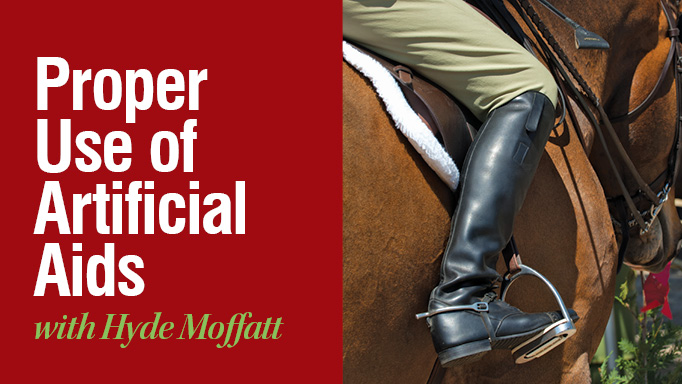Artificial aids are designed to enhance the natural aids. The basic artificial aids – the stick and spurs – are a good complement to your regular aids of the legs, hands, seat, and voice.
Properly used, artificial aids are there to make a correction to a non-response of an aid. If, for example, the proper usage of the leg aid is applied and the horse is not responding in the appropriate or expected manner, then the artificial aid can be used as a reminder of the first aid. It is important that the artificial aids never be used as a primary aid, but only as a useful reminder that the primary aid is there for a reason.
The only way that any of the artificial aids work well is if all the natural aids are used consistently. It’s important that you always ask the horse the same way and expect the same response. If riders are doing everything the same way every time, the horse’s response should become consistent. The artificial aids are there for when that response is diminished as a way of reminding that there is an appropriate response to it.
The stick is relatively simple, because it has to be a deliberate action and can’t be used as easily in error, but the spurs are tricky. Before I introduce the spurs I want to see very good control of the leg, as you don’t want the artificial aid to mistakingly become the primary aid. My riders need a solid base of support and a 100% confirmed consistent leg position. I want riders to have proper use of the leg, correct pressure and position of the leg, and then be able to remind the horse using the spur only if necessary. I ride most of my horses in spurs, especially for flatwork. I actually won’t show some that I ride in spurs, as I can create a bit more pressure and support in the ring without getting so much of a reaction.
I teach all my riders to use their voice prior to using the stick. I believe you should apply leg pressure first, and if the leg pressure doesn’t yield the desired results then you cluck, and then a tap behind the leg with the stick so there is a connection between the voice and the stick. That way, if you ever run into trouble somewhere on course you can cluck, and the connection will yield that forward result right away. The most important thing is the relay; that the pressure from the legs always happens first and always happens in the right place before going to stick or spurs. We want a predictable and programmed response from the leg, and the stick and spurs are there simply there to help us reinforce that response.
It is important to note that the stick or spur should never be used in anger, as it can confuse the horse if you include emotion in training. Artificial aids should only be used in a cool, calm, and collected manner, and the horse must understand why you are applying them. Tapping with the stick may not yield the kind of response that you were hoping for if the horse is confused, misguided, or spun, so it’s very important that the rider is organized and understands what the horse’s perception of the situation is.
Hyde Moffatt is a rider, coach, trainer, and clinician who runs AHM Enterprises in Brantford, ON, specializing in developing young prospects into grand prix horses. He is also the chef d’équipe of the Canadian Young Riders Team.

